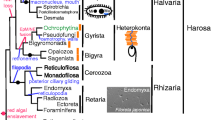Abstract.
In the unicellular green alga, Chlamydomonas reinhardtii, cytochrome oxidase subunit 2 (cox2) and 3 (cox3) genes are missing from the mitochondrial genome. We isolated and sequenced a BAC clone that carries the whole cox3 gene and its corresponding cDNA. Almost the entire cox2 gene and its cDNA were also determined. Comparison of the genomic and the corresponding cDNA sequences revealed that the cox3 gene contains as many as nine spliceosomal introns and that cox2 bears six introns. Putative mitochondria targeting signals were predicted at each N terminal of the cox genes. These spliceosomal introns were typical GT–AG-type introns, which are very common not only in Chlamydomonas nuclear genes but also in diverse eukaryotic taxa. We found no particular distinguishing features in the cox introns. Comparative analysis of these genes with the various mitochondrial genes showed that 8 of the 15 introns were interrupting the conserved mature protein coding segments, while the other 7 introns were located in the N-terminal target peptide regions. Phylogenetic analysis of the evolutionary position of C. reinhardtii in Chlorophyta was carried out and the existence of the cox2 and cox3 genes in the mitochondrial genome was superimposed in the tree. This analysis clearly shows that these cox genes were relocated during the evolution of Chlorophyceae. It is apparent that long before the estimated period of relocation of these mitochondrial genes, the cytosol had lost the splicing ability for group II introns. Therefore, at least eight introns located in the mature protein coding region cannot be the direct descendant of group II introns. Here, we conclude that the presence of these introns is due to the invasion of spliceosomal introns, which occurred during the evolution of Chlorophyceae. This finding provides concrete evidence supporting the ``intron-late'' model, which rests largely on the mobility of spliceosomal introns.
Similar content being viewed by others
Author information
Authors and Affiliations
Additional information
Received: 22 August 2000 / Accepted: 28 February 2001
Rights and permissions
About this article
Cite this article
Watanabe, K., Ohama, T. Regular Spliceosomal Introns Are Invasive in Chlamydomonas reinhardtii: 15 Introns in the Recently Relocated Mitochondrial cox2 and cox3 Genes. J Mol Evol 53, 333–339 (2001). https://doi.org/10.1007/s002390010223
Issue Date:
DOI: https://doi.org/10.1007/s002390010223




